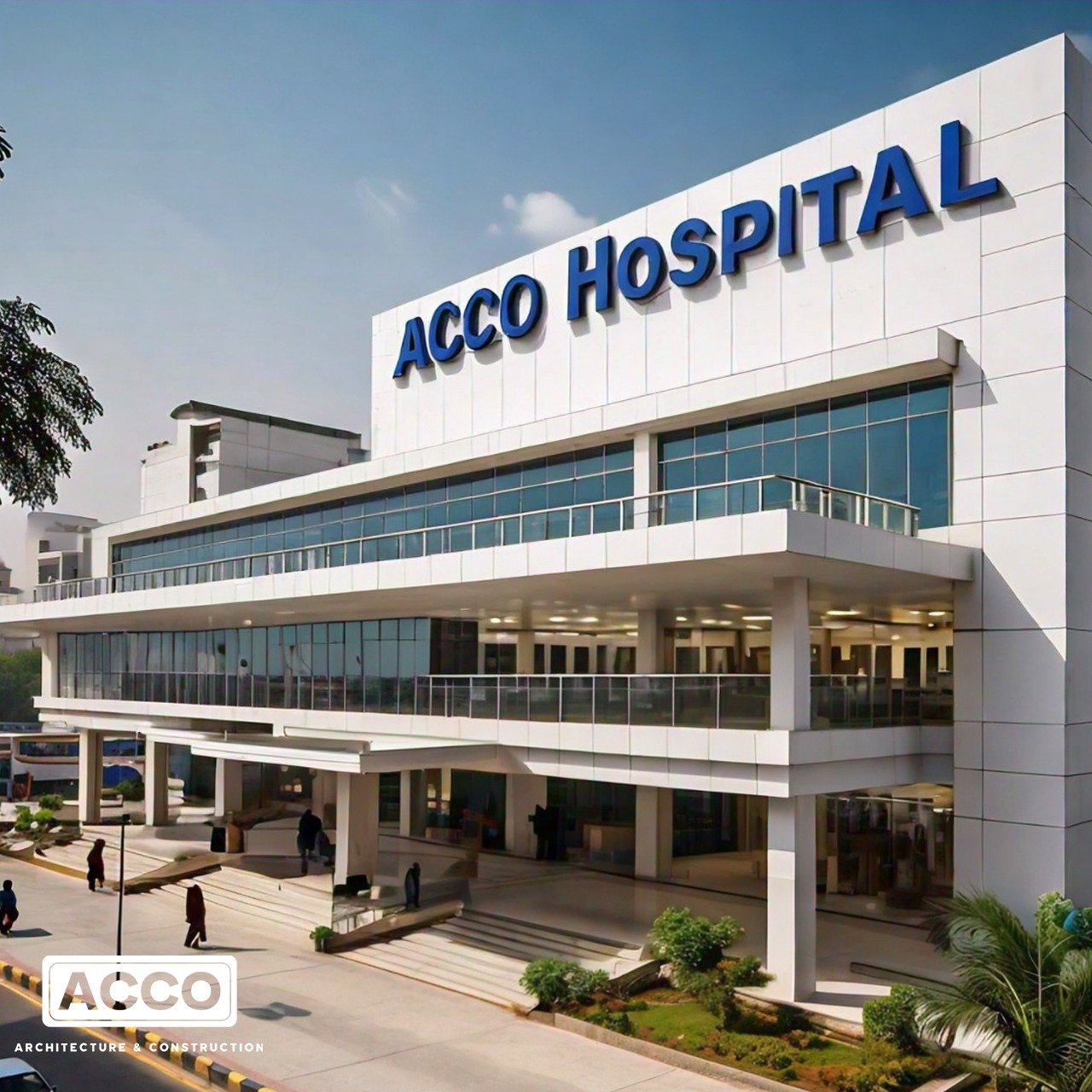
How Modern Architecture is Redefining Hospital Design in Pakistan
Modern architecture is playing a transformative role in redefining hospital design in Pakistan, driven by firms like ACCO that are integrating global design trends with local needs to create state-of-the-art healthcare facilities. This new approach prioritizes patient-centered care, sustainability, and adaptability, blending advanced technologies with innovative design principles. The result is a reimagining of how hospitals function and the overall healthcare experience for patients, staff, and communities.
Key Ways Modern Architecture is Redefining Hospital Design in Pakistan:
1. Patient-Centered and Healing Environments
- Focus: Modern hospital architecture in Pakistan is increasingly emphasizing the patient experience by creating healing environments that promote recovery and well-being. This includes incorporating natural light, green spaces, calming interior designs, and private patient rooms.
- Impact: These design elements reduce stress, improve mental health, and contribute to faster recovery times, shifting hospitals from purely functional spaces to environments that actively support healing.
2. Sustainability and Green Building Practices
- Focus: Sustainability is becoming a core principle in modern hospital design, with an emphasis on energy-efficient systems, water conservation, and the use of eco-friendly materials. ACCO and other leading firms are incorporating renewable energy sources such as solar panels, green roofs, and sustainable construction methods to reduce environmental impact.
- Impact: Green hospital design not only reduces operational costs but also contributes to the well-being of patients and staff by improving indoor air quality, reducing waste, and creating healthier spaces. This aligns with global sustainability goals and supports the long-term viability of healthcare facilities.
3. Integration of Advanced Technologies
- Focus: The integration of cutting-edge technologies, such as smart patient monitoring systems, AI-driven diagnostics, and automated hospital management systems, is a hallmark of modern hospital architecture. This allows for more efficient use of resources and improves patient care.
- Impact: The incorporation of smart technologies in hospital design enables real-time data collection, remote patient monitoring, and enhanced communication between healthcare professionals. This leads to more personalized care, quicker diagnostics, and overall better health outcomes.
4. Flexible and Adaptive Spaces
- Focus: Modern architecture prioritizes flexibility in hospital design, enabling spaces to adapt to changing needs over time. This is achieved through modular construction, adaptable layouts, and multi-functional areas that can be reconfigured quickly for different uses, such as expanding intensive care units or setting up temporary facilities during health crises like pandemics.
- Impact: The ability to quickly modify hospital spaces ensures that healthcare facilities remain responsive to evolving healthcare demands, whether it’s accommodating new medical technologies, expanding capacity, or adjusting to new patient care models.
5. Biophilic Design
- Focus: Biophilic design, which incorporates elements of nature into the built environment, is gaining traction in hospital architecture. This includes the use of natural materials, plants, water features, and large windows that allow for abundant natural light and views of nature.
- Impact: Studies have shown that exposure to nature helps reduce patient stress, improve mood, and enhance recovery rates. Hospitals that embrace biophilic design create a more pleasant and calming environment for both patients and staff, contributing to overall well-being.
6. Community-Centered Hospitals
- Focus: Modern hospital design is increasingly shifting towards community integration, where hospitals serve not only as treatment centers but as community health hubs. This includes spaces for wellness programs, health education, and preventive care services that cater to the broader community beyond just those seeking medical treatment.
- Impact: By embedding hospitals within the community and offering a range of services that promote general health and wellness, modern hospitals contribute to reducing the need for acute care and encourage healthier lifestyles among the population.
7. Optimized Workflow and Efficiency
- Focus: Efficient hospital design is critical for reducing staff fatigue and ensuring timely patient care. Modern hospital architecture focuses on optimizing workflows by creating logical layouts that reduce travel times for healthcare workers, centralize key services, and improve access to critical care areas like operating rooms and emergency departments.
- Impact: These design enhancements lead to more efficient hospital operations, reduced wait times for patients, and a more streamlined healthcare delivery process. Staff are able to work more effectively in environments designed to minimize unnecessary movement and maximize productivity.
8. Incorporating Local Cultural and Climatic Considerations
- Focus: Modern hospital architecture in Pakistan is also adapting to local cultural and climatic conditions. Designs are being tailored to reflect cultural preferences, such as the need for privacy in patient rooms and gender-specific spaces. In addition, hospitals are being designed to cope with the local climate, incorporating passive cooling systems, shaded courtyards, and natural ventilation.
- Impact: By considering local cultural norms and climate, modern hospital designs create more comfortable and respectful environments for patients, staff, and visitors. This culturally sensitive approach ensures that hospitals are welcoming and appropriate for the communities they serve.
9. Enhanced Focus on Infection Control
- Focus: The COVID-19 pandemic has highlighted the importance of infection control in hospital design. Modern hospitals are being designed with advanced infection control measures, such as improved ventilation systems, antimicrobial surfaces, and dedicated isolation wards to prevent the spread of infectious diseases.
- Impact: These measures are critical for ensuring patient and staff safety and reducing the risk of hospital-acquired infections. Hospitals designed with infection control in mind are better equipped to handle pandemics and other public health emergencies.
10. Enhanced Aesthetic Appeal
- Focus: Beyond functionality, modern hospital architecture in Pakistan is placing greater emphasis on aesthetic appeal. Architects are designing hospitals that are visually striking and uplifting, incorporating contemporary design elements that break away from the traditional sterile hospital look.
- Impact: The enhanced aesthetic appeal contributes to a more positive patient experience, reducing the anxiety often associated with hospital visits. Attractive, well-designed hospitals also help improve staff morale, creating a more pleasant working environment.
Conclusion:
Modern architecture, as championed by firms like ACCO, is redefining hospital design in Pakistan by focusing on patient-centered care, sustainability, advanced technology integration, and adaptable spaces. These innovations are not only improving the functionality of hospitals but also creating environments that promote healing, efficiency, and community well-being. The future of hospital design in Pakistan is set to further evolve, making healthcare facilities more responsive to the needs of patients, staff, and society at large.
4oHospital Design,Healthcare Architecture,Patient-Centered Care,Sustainable Hospitals,Innovative Healthcare,Smart Hospitals,Healing Environments,Hospital Trends,Future of Healthcare,Biophilic Design,Green Building,Telemedicine Facilities,Modular Hospitals,Hospital Efficiency,Community Health Centers,Healthcare Innovation,Hospital Layouts,Flexible Spaces,Ergonomic Design,Design Thinking in Healthcare,Accessibility in Hospitals,Patient Experience,Healthcare Facilities Management,Advanced Medical Technology,Wellness-Focused Design,Infection Control Design,Natural Lighting in Hospitals,Acoustic Design in Healthcare,Hospital Landscaping,Color Psychology in Hospitals,Digital Health Solutions,Space Optimization,Emergency Room Design,Outpatient Facilities,Pediatric Hospital Design,Rehabilitation Spaces,Multi-Functional Spaces,Healthcare Sustainability,Hospital Design Guidelines,Universal Design Principles,Indoor Air Quality,Staff Efficiency,Patient Privacy,Design for Mental Health,Cultural Sensitivity in Design,Technology Integration,Healthcare Aesthetics,Community Engagement,Research in Hospital Design,Evidence-Based Design,Hospital Design Trends 2024,Patient Flow Management,Public Health Facilities,Hospital Renovations,Healthcare Design Competitions,Sustainable Materials,Smart Technology in Healthcare,Telehealth Design,Ambient Intelligence,Waiting Room Design,Hospital Signage Systems,Emergency Preparedness Design,Nurse Station Design,Safety and Security in Hospitals,Vertical Gardens in Hospitals,Patient Transport Design,Aging Population Healthcare,Family-Centered Care Design,Interdisciplinary Team Spaces,Hospital Branding,Integrated Care Models,Hospital Design Software,3D Modeling in Healthcare,Collaborative Spaces in Hospitals,Digital Wayfinding,Trauma-Informed Care Environments,Hospital Art Programs,Disaster Resilience in Design,Smart Lighting in Healthcare,Technology in Patient Care,Sustainable Energy in Hospitals,Community-Focused Health Initiatives,Innovative Patient Rooms,Healthcare Staff Amenities,Patient Empowerment Through Design,Behavioral Health Facilities,Hospital Workflow Optimization,Design for Diverse Populations,Care Transitions,Hospital Food Service Design,Staff Training Facilities,Patient Engagement Strategies,Cross-Disciplinary Design Teams,Green Roofs in Hospitals,Resilience in Healthcare Design,Telemedicine Infrastructure,Hospital Design Case Studies,International Hospital Design Standards,Patient Safety in Design,Hospital Design Regulations,Hospital Design Software Tools,Future of Hospital Care,Integrated Healthcare Systems,Healthcare Design Research,Hospital Design Reviews,Healthcare Service Delivery,User-Centered Design,Hospital Experience Improvement,Technological Advancements in Healthcare,Community Health Strategies,Modern Healthcare Design,Patient and Family Advisory Councils,Public Health Infrastructure,Hospital Parking Solutions,Clinical Space Design,Patient-Oriented Spaces,Infection Prevention Through Design,Cross-Cultural Hospital Design,Health Informatics in Design,Outpatient Care Trends,Space Utilization Studies,Patient Privacy Design,Healthcare Communication Design,Hospital Energy Efficiency,Cultural Competency in Healthcare,Hospital Funding Trends,Hospital Design Innovations,User Experience in Healthcare,Healing Gardens in Hospitals,Remote Patient Monitoring,Hospital Space Planning,Community Partnership in Healthcare,Accessibility Design in Hospitals,Hospital Design Workshops,Emergency Services Design,Hospital Security Design,Patient Flow Analysis,Landscape Design in Healthcare,Hospital Wayfinding Systems,Medical Office Design,Healthcare Design Trends,Data-Driven Design in Hospitals,Inclusive Design Practices,Hospital Kitchen Design,Hospital Transport Systems,Healthcare Delivery Models,Community-Based Care Facilities,Health Systems Strengthening,Interior Design in Hospitals,Hospital User Feedback,Public Health Challenges,Hospital Design Consultations,Design for Health Equity,Technological Integration in Hospitals,Hospital Renovation Best Practices,Care Environment Design,Hospital Design Inspirations,Digital Health Integration,Quality of Care Improvements,Hospital Staff Satisfaction,Hospital Design Resources,Design Trends in Patient Care,Healthcare Service Models,Future Hospital Concepts,Healthcare Design Publications,Hospital Staff Collaboration,Design for Chronic Illness Care,Hospital Community Engagement,Safety in Healthcare Design,Public-Private Partnerships in Healthcare,Hospital Design Flexibility,Patient-Centric Design Principles,Healthcare Design Strategies,Hospital Innovation Labs,Interdisciplinary Healthcare Teams,Patient-Centered Medical Homes,Hospital Design Learning,Healing Architecture,Future-Proof Hospital Design,Healthcare Transformation,Hospital Research Initiatives,Hospital Technology Trends,Design for Patient Outcomes,Hospital Environmental Impact,Health Promotion Through Design,Hospital Space Efficiency,Community Health Advocacy,Hospital Building Performance,Healthcare Market Trends,Hospital Service Accessibility,Patient Care Technology,Hospital Operational Efficiency,Healthcare Collaboration,Health and Wellness Design,Healthcare Systems Design,Hospital Safety Standards,Healthcare Design Networking,Innovation in Patient Care,Hospital Design Futures,Healthcare Design Collaboration,



